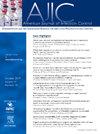Clusters of emerging multidrug-resistant organisms in US health care facilities during the initial months of the SARS-CoV-2 pandemic
IF 3.8
3区 医学
Q2 INFECTIOUS DISEASES
引用次数: 0
Abstract
Background
Outbreaks of emerging multidrug-resistant organisms (eMDROs), including carbapenem-resistant Enterobacterales, carbapenem-resistant Acinetobacter baumannii, and Candida auris, have been reported among severe acute respiratory syndrome coronavirus 2 (SARS-CoV-2) patients. We describe eMDRO clusters in SARS-CoV-2 units and associated infection control (IC) practices early in the SARS-CoV-2 pandemic.
Methods
We conducted a retrospective survey of a convenience sample of health departments in 11 states to describe clusters of eMDROs that began before November 1, 2020 and involved SARS-CoV-2 units. Cluster characteristics and IC practices during the cluster period were assessed using a standardized outbreak report form, and descriptive analyses were performed.
Results
Overall, 18 eMDRO clusters (10 carbapenem-resistant Enterobacterales, 6 C auris, 1 carbapenem-resistant Pseudomonas aeruginosa, and 1 carbapenem-resistant A baumannii) in 18 health care facilities involving 397 patients were reported from 10 states. During the cluster period, 60% of facilities reported a shortage of isolation gowns, 69% extended use of gowns, and 67% reported difficulty obtaining preferred disinfectants. Reduced frequency of hand hygiene audits was reported in 85% of acute care hospitals during the cluster period compared with before the pandemic.
Conclusions
Changes in IC practices and supply shortages were identified in facilities with eMDRO outbreaks during the SARS-CoV-2 pandemic and might have contributed to eMDRO transmission.
SARS-CoV-2 大流行最初几个月美国医疗机构中新出现的耐多药生物群。
背景:据报道,SARS-CoV-2患者中爆发了新出现的多重耐药菌(eMDRO),包括耐碳青霉烯类肠杆菌(CRE)、耐碳青霉烯类鲍曼不动杆菌(CRAB)和白色念珠菌。我们描述了在 SARS-CoV-2 大流行早期,SARS-CoV-2 病房中的 eMDRO 群和相关的感染控制(IC)措施:我们对 11 个州的卫生部门进行了回顾性抽样调查,以描述 2020 年 11 月 1 日前开始的涉及 SARS-CoV-2 单位的 eMDRO 群组。使用标准化的疫情报告表对群集特征和群集期间的集成电路实践进行了评估,并进行了描述性分析:结果:10 个州共报告了 18 家医疗机构的 18 例 eMDRO 群体(10 例 CRE、6 例 C.auris、1 例耐碳青霉烯类铜绿假单胞菌和 1 例 CRAB),涉及 397 名患者。在群集期间,60% 的医疗机构报告隔离衣短缺,69% 的医疗机构延长了隔离衣的使用时间,67% 的医疗机构报告难以获得首选消毒剂。据报告,与大流行之前相比,85%的急症护理医院在大流行期间减少了手部卫生审核的频率:结论:在SARS-CoV-2大流行期间,在爆发eMDRO疫情的机构中发现了IC操作方法的改变和供应短缺,这可能是导致eMDRO传播的原因之一。
本文章由计算机程序翻译,如有差异,请以英文原文为准。
求助全文
约1分钟内获得全文
求助全文
来源期刊
CiteScore
7.40
自引率
4.10%
发文量
479
审稿时长
24 days
期刊介绍:
AJIC covers key topics and issues in infection control and epidemiology. Infection control professionals, including physicians, nurses, and epidemiologists, rely on AJIC for peer-reviewed articles covering clinical topics as well as original research. As the official publication of the Association for Professionals in Infection Control and Epidemiology (APIC)

 求助内容:
求助内容: 应助结果提醒方式:
应助结果提醒方式:


